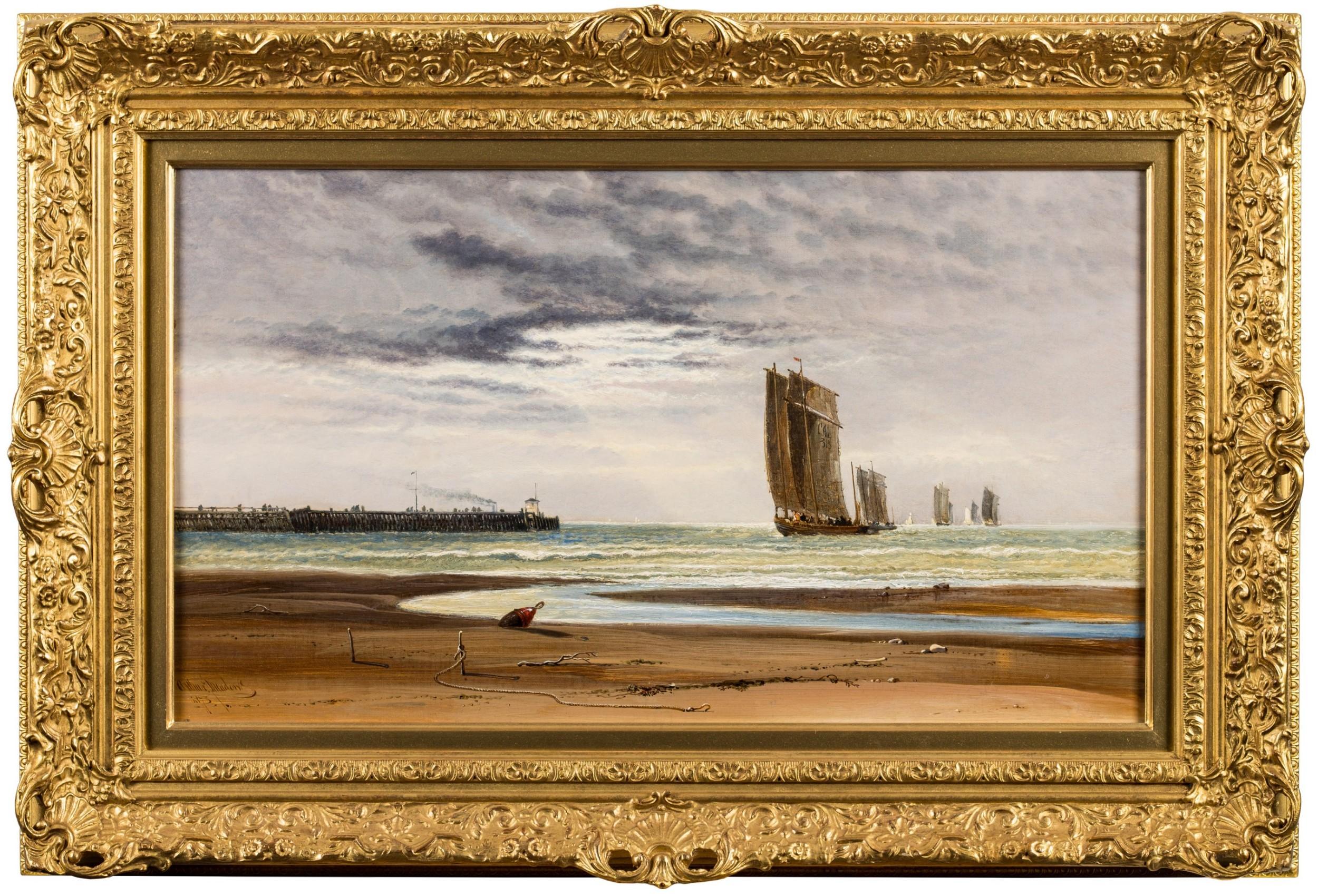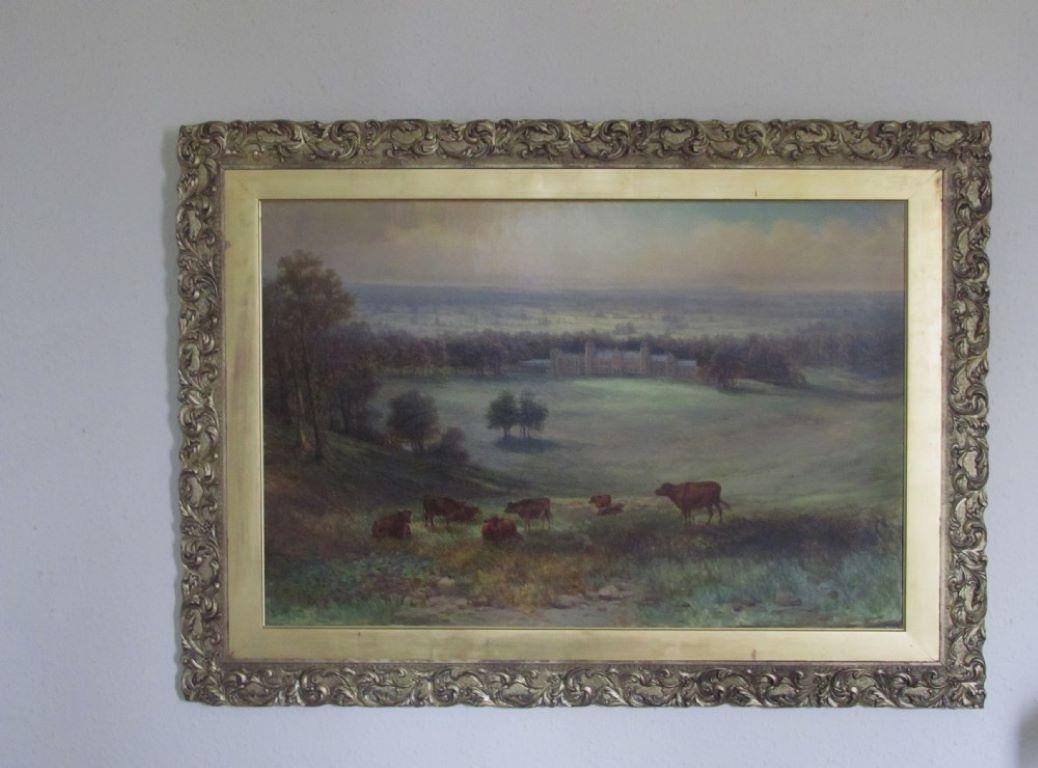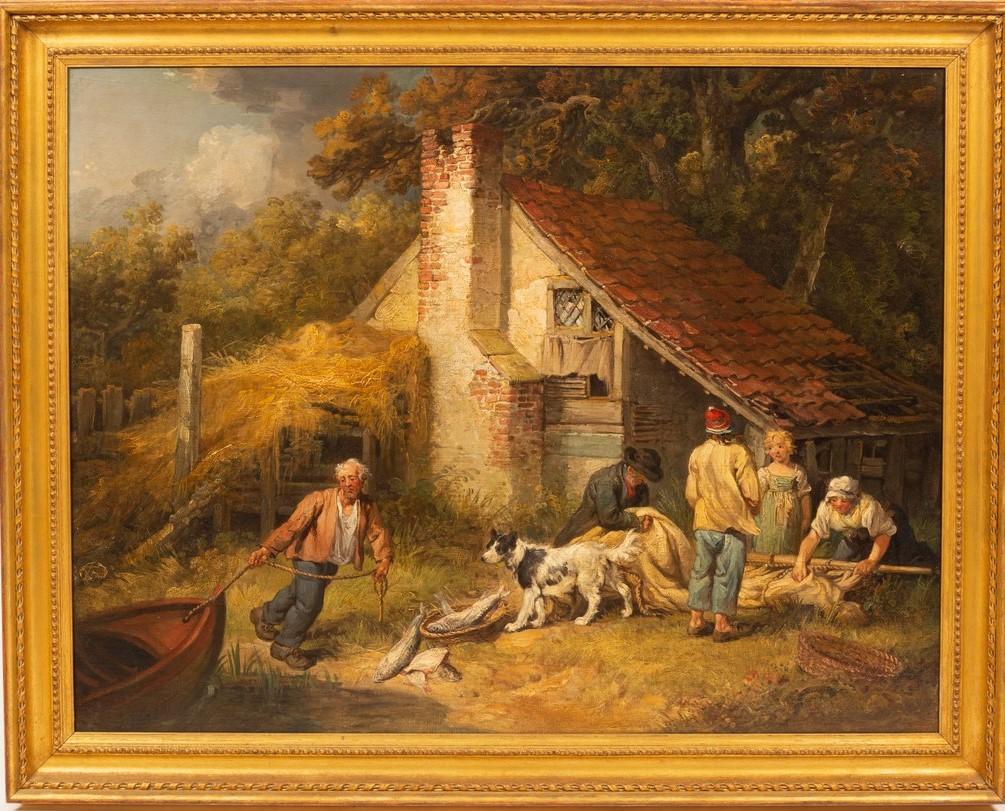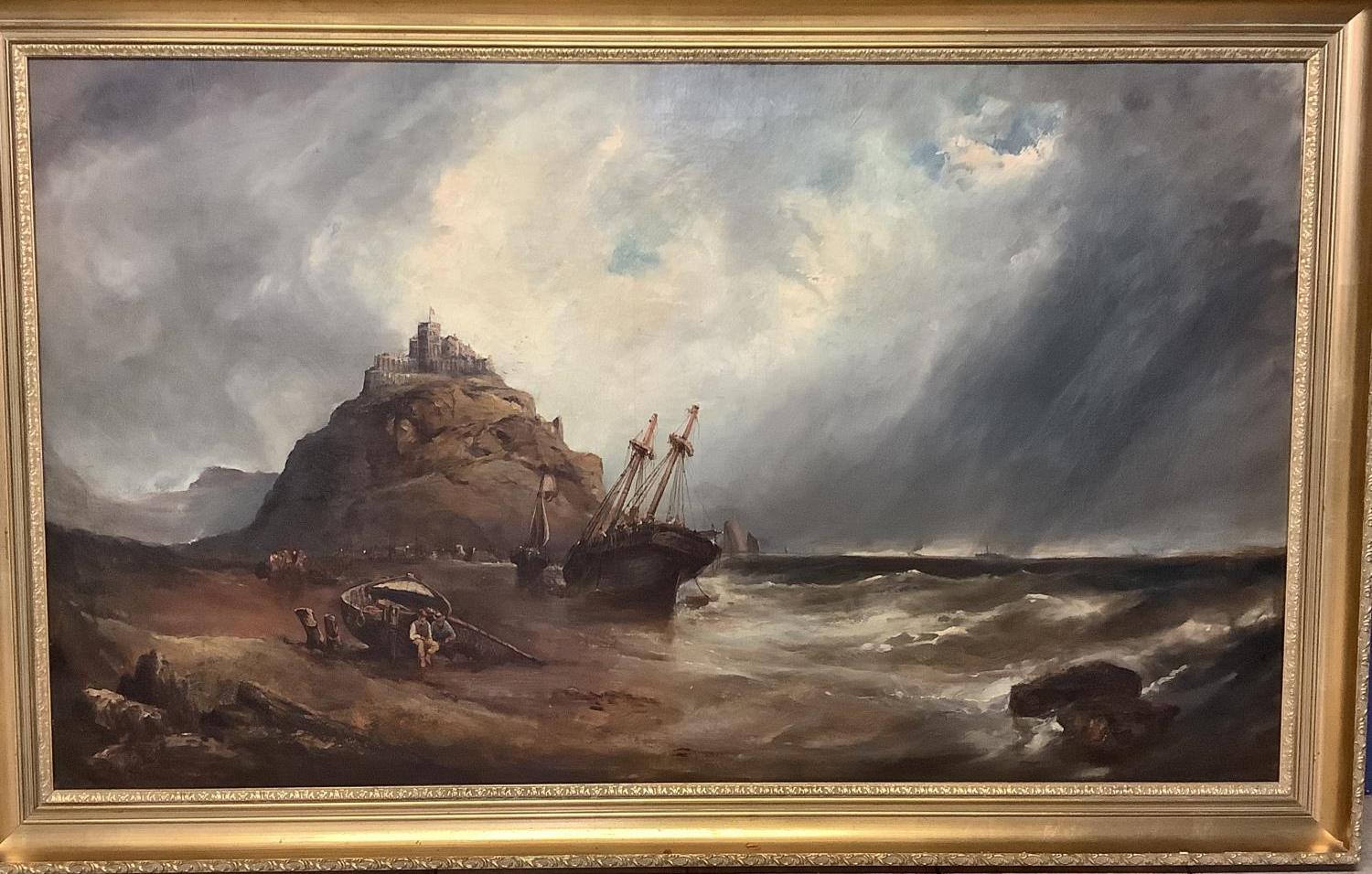Items Similar to "A Dutch Canal" Oil Painting from The Circle of Aert van der Neer
Want more images or videos?
Request additional images or videos from the seller
1 of 5
"A Dutch Canal" Oil Painting from The Circle of Aert van der Neerca. 1650
ca. 1650
About the Item
'Dutch Canal' is an original oil painting by an artist in the school or circle of Dutch Golden Age painter Aert van der Neer. Based on the labels on the artwork, the painting has borne an attribution to Aert van der Neer since approximately the late 19th century. As is typical of works by van der Neer and his circle, it depicts a number of figures interacting within the landscape – rowing a boat, chatting at the edge of a private property, and walking through the woods. Indeed, this work is similar to a work with full attribution to van der Neer at the Metropolitan Museum of Art entitled 'Landscape at Sunset" (17.190.11) which likewise features such staffage. Nonetheless, a full attribution to Aert van der Neer is here unfitting; van der Neer's landscapes are usually more moody and show special attention to the effects of light and atmosphere. Here, however, the sky is a bright and luminous blue like those seen in works by Jacob van Ruisdael or Meindert Hobbema. Regardless of attribution, the painting shows the skill of artists in the Dutch Golden Age and the tastes of patrons of that period. "Dutch canal," with its careful attention to detail and realism portrays a distinctly Dutch mode of ordering the landscape. According to Peter Sutton:
"As no other people before them, the Dutch in the seventeenth century compiled a remarkably comprehensive record in paint of their land, people, and possessions. What nineteenth-century art historian like Eugene Fromentin called the 'probity' of Dutch art--its record of fact and compelling truth to life--was perhaps more clearly expressed in landscape than in any other genre; the Dutch, for all intents and purposes, invented the naturalistic landscape. ... Yet for all its inventory of fact and observation, Dutch landscape was neither a literal speculum naturae (mirror of reality) for a topographically exact traveler's journal. The Dutchman's painterly imagination reformed nature ... We no longer rest easy with uncomplicated notions of a naive Dutch realism chronicling the countryside with the literalness of a camera lens. Nor can we accept the view of Dutch landscape as a portrait of the land, unless one acknowledges the portraitist's license to editorialize, recast and flatter."
Thus, despite the seemingly true-to-life naturalism of the Dutch landscape, Netherlandish artists reordered the landscape, aiming to fool and delight the eye. As artist Samuel van Hoogstraten said, painting should be "an image inspired by natural observation but altered and embellished so that it 'deceives' in an acceptable, pleasing, and praiseworthy way."
16 x 20 inches, canvas
23.63 x 27.75 inches, frame
apparently unsigned
plaque affixed to frame with title "A Dutch Canal" and attribution to Aert van der Neer, bottom center
inscribed "Van de Neer" in pencil, on reverse of frame, upper right
inscribed "17B" in pencil, on reverse of stretcher, upper left
indecipherable label with red border on reverse of stretcher, upper left
inscribed "A van der Neer" in pencil, on reverse of stretcher, upper right
label with biography of Aert van der Neer on reverse of stretcher, bottom center
Presented in a wood and composition frame with gold leaf finish.
Overall good restored condition; relined; areas of retouching, especially in the sky; craquelure throughout; some planar distortion along bottom edge; some surface losses to frame.
- Creation Year:ca. 1650
- Dimensions:Height: 23.625 in (60.01 cm)Width: 27.75 in (70.49 cm)
- Medium:
- Movement & Style:
- Circle Of:Aert Van Der Neer (1603 - 1677, Dutch)
- Period:Mid-17th Century
- Framing:Frame IncludedFraming Options Available
- Condition:Overall good restored condition; relined; areas of retouching, especially in the sky; craquelure throughout; some planar distortion along bottom edge; some surface losses to frame.
- Gallery Location:Milwaukee, WI
- Reference Number:
About the Seller
4.9
Platinum Seller
These expertly vetted sellers are 1stDibs' most experienced sellers and are rated highest by our customers.
Established in 1966
1stDibs seller since 2017
390 sales on 1stDibs
Typical response time: 1 hour
- ShippingRetrieving quote...Ships From: Milwaukee, WI
- Return PolicyA return for this item may be initiated within 14 days of delivery.
More From This SellerView All
- "Town Scene, " Oil on Canvas European Cityscape by Petrus Gerardus VertinLocated in Milwaukee, WI"Town Scene" is an original oil on canvas by Petrus Gerardus Vertin. The city scene shows an idyllic view of a bustling European city of the pas...Category
19th Century Old Masters Landscape Paintings
MaterialsCanvas, Oil
- Ucross Square IIILocated in Milwaukee, WI"Ucross Square III" is an original oil painting on masonite board signed by the artist in the lower right. It depicts three black cows against a yellow rolling field landscape. Foste...Category
Early 2000s Landscape Paintings
MaterialsMasonite, Oil
- Industrial Impressionist Travel Mississippi River Fishing Bridge Sunrise SignedLocated in Milwaukee, WI"Mississippi Working Barge" is an original oil painting created by Thomas Buchs. This is a plein air painting that Thomas Buchs did on his travels. Buchs ...Category
2010s American Impressionist Landscape Paintings
MaterialsCanvas, Oil, Panel
- "Autumn Trees, " Original Oil Landscape Painting unique designBy Michael BoyleLocated in Milwaukee, WI"Autumn Trees" is an original, unique landscape oil painting on canvas by Michael Boyle. The artist signed the piece lower right and dated it lower left. This piece depicts a line of...Category
1980s Impressionist Landscape Paintings
MaterialsCanvas, Oil
- 'Beige House' original oil on wood painting signed by Robert RichterBy Robert RichterLocated in Milwaukee, WIIn this painting, Robert Richter depicts a view over the top of a suburban fence, peeking into the backyard of a neighbor. Over the rounded wooden pickets are thickets of trees in a ...Category
2010s Outsider Art Landscape Paintings
MaterialsOil, Wood Panel
- 'Mall Bird' original oil on wood painting signed by Robert RichterBy Robert RichterLocated in Milwaukee, WIThis painting, 'Mall Bird,' presents a black bird in an urban landscape using the humor and irony common to Robert Richter's oeuvre. The bird stands in the foreground atop the regula...Category
2010s Outsider Art Landscape Paintings
MaterialsWood Panel, Oil
You May Also Like
- Early oil depicting the Great Fire of LondonLocated in London, GBThe Great Fire of London in September 1666 was one of the greatest disasters in the city’s history. The City, with its wooden houses crowded together in narrow streets, was a natural fire risk, and predictions that London would burn down became a shocking reality. The fire began in a bakery in Pudding Lane, an area near the Thames teeming with warehouses and shops full of flammable materials, such as timber, oil, coal, pitch and turpentine. Inevitably the fire spread rapidly from this area into the City. Our painting depicts the impact of the fire on those who were caught in it and creates a very dramatic impression of what the fire was like. Closer inspection reveals a scene of chaos and panic with people running out of the gates. It shows Cripplegate in the north of the City, with St Giles without Cripplegate to its left, in flames (on the site of the present day Barbican). The painting probably represents the fire on the night of Tuesday 4 September, when four-fifths of the City was burning at once, including St Paul's Cathedral. Old St Paul’s can be seen to the right of the canvas, the medieval church with its thick stone walls, was considered a place of safety, but the building was covered in wooden scaffolding as it was in the midst of being restored by the then little known architect, Christopher Wren and caught fire. Our painting seems to depict a specific moment on the Tuesday night when the lead on St Paul’s caught fire and, as the diarist John Evelyn described: ‘the stones of Paul’s flew like grenades, the melting lead running down the streets in a stream and the very pavements glowing with the firey redness, so as no horse, nor man, was able to tread on them.’ Although the loss of life was minimal, some accounts record only sixteen perished, the magnitude of the property loss was shocking – some four hundred and thirty acres, about eighty per cent of the City proper was destroyed, including over thirteen thousand houses, eighty-nine churches, and fifty-two Guild Halls. Thousands were homeless and financially ruined. The Great Fire, and the subsequent fire of 1676, which destroyed over six hundred houses south of the Thames, changed the appearance of London forever. The one constructive outcome of the Great Fire was that the plague, which had devastated the population of London since 1665, diminished greatly, due to the mass death of the plague-carrying rats in the blaze. The fire was widely reported in eyewitness accounts, newspapers, letters and diaries. Samuel Pepys recorded climbing the steeple of Barking Church from which he viewed the destroyed City: ‘the saddest sight of desolation that I ever saw.’ There was an official enquiry into the causes of the fire, petitions to the King and Lord Mayor to rebuild, new legislation and building Acts. Naturally, the fire became a dramatic and extremely popular subject for painters and engravers. A group of works relatively closely related to the present picture have been traditionally ascribed to Jan Griffier...Category
17th Century Old Masters Landscape Paintings
MaterialsOil, Canvas
- Stag Hunting in the Vicinity of Nuremberg by a German Artist Peter von BemmelLocated in PARIS, FRThis small landscape shows a hunting scene: two riders are chasing a stag with their dogs at the edge of a forest. Signed by Peter von Bemmel, it is typical of the production of this...Category
1720s Old Masters Landscape Paintings
MaterialsCopper
- Arthur Joseph Meadows 19th Century Seascape Off CalaisBy Arthur Joseph MeadowsLocated in York, GBA very fine painting by the renowned seascape painter Arthur Joseph Meadows,Off Calais; fishing fleet returning at low tide. Housed in an antique style gilt frame the size overall is...Category
19th Century Old Masters Landscape Paintings
MaterialsOil
- 19th Century, Victorian, landscape , cows , Country House Samuel Lawson BoothLocated in York, GBS Lawson Booth : Country House in extensive landscape with cattle in the foreground, oil on canvas signed and dated '98, 60cm x 90cm (35x23 inches approx image) size with frame appro...Category
19th Century Old Masters Landscape Paintings
MaterialsOil
- James ward landscape oil Bringing in the CatchBy James WardLocated in York, GBJames ward landscape oil Bringing in the Catch A charming scene of a family "bringing in the catch" showing figures outside a cottage, man pullng in the boat with his dog watching by...Category
19th Century Old Masters Landscape Paintings
MaterialsOil
- St Michael's Mount, Cornwall Seascape OilLocated in York, GBThis early 20th century oil on canvas depicts a nautical scene with a view of St Michaels Mount beyond. Although as yet, not attributed to a particular artist,this painting has cl...Category
Early 20th Century Old Masters Landscape Paintings
MaterialsOil





